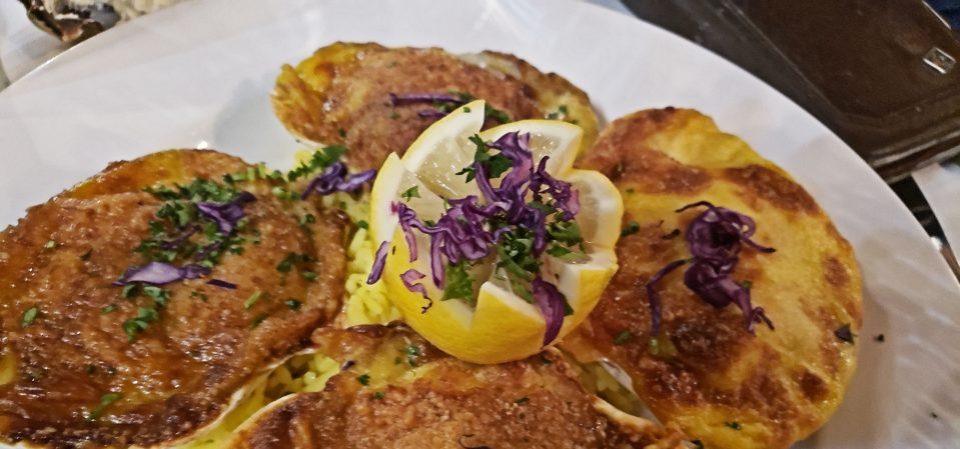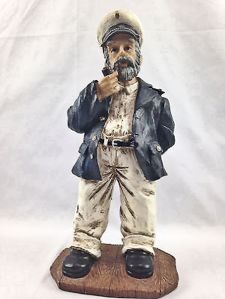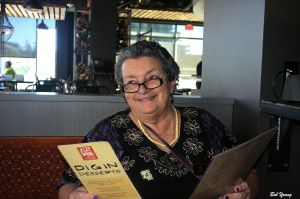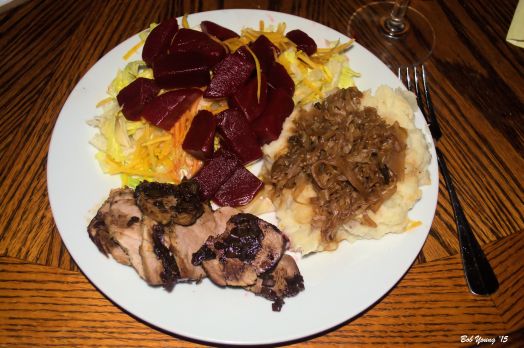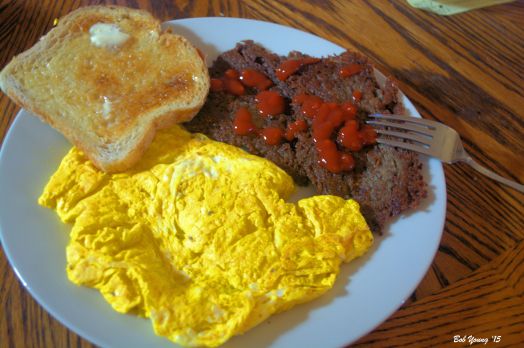 Scrapple is an acquired taste. It has been described as “everything from the pig except the oink!” We have our scrapple shipped in from Ralph and Paul Adams, Rapa Brand Scrapple in Philadelphia. I’m a purist. I like the original scrapple and will probably leave the turkey scrapple alone. Wikipedia says,
Scrapple is an acquired taste. It has been described as “everything from the pig except the oink!” We have our scrapple shipped in from Ralph and Paul Adams, Rapa Brand Scrapple in Philadelphia. I’m a purist. I like the original scrapple and will probably leave the turkey scrapple alone. Wikipedia says,
Scrapple, also known by the Pennsylvania Dutch name panhaas or “pan rabbit,” is traditionally a mush of pork scraps and trimmings combined with cornmeal and wheat flour, often buckwheat flour, and spices. The mush is formed into a semi-solid congealed loaf, and slices of the scrapple are then pan-fried before serving. Scraps of meat left over from butchering, not used or sold elsewhere, were made into scrapple to avoid waste. Scrapple is best known as a rural American food of the Mid-Atlantic states (Delaware, Maryland, New Jersey, Pennsylvania and Virginia). Scrapple and panhaas are commonly considered an ethnic food of the Pennsylvania Dutch, including the Mennonites and Amish. Scrapple is found in supermarkets throughout the region in both fresh and frozen refrigerated cases.
Preparation
Scrapple is typically cut into quarter-inch to three-quarter-inch slices and pan-fried until brown to form a crust. It is sometimes first coated with flour. It may be fried in butter or oil and is sometimes deep-fried. Scrapple can also be broiled; this is a good cooking method for those who like their scrapple crisp. Scrapple is usually eaten as a breakfast side dish. It can be served plain or with either sweet or savory condiments: apple butter, ketchup, jelly, maple syrup, honey, or mustard. The state of Maryland is particularly in favor of scrapple topped with grape jelly. In some regions, such as New England, scrapple is mixed with scrambled eggs and served with toast. In the Philadelphia area, scrapple is sometimes fried and then mashed with fried eggs, horseradish, and ketchup.
History and regional popularity
The roots of the culinary traditions that led to the development of scrapple in America have been traced back to pre-Roman Europe. The more immediate culinary ancestor of scrapple was the Low German dish called panhas, which was adapted to make use of locally available ingredients, and it is still called “Pannhaas,” “panhoss,” “ponhoss,” or “pannhas” in parts of Pennsylvania. The first recipes were created by German colonists who settled near Philadelphia and Chester County, Pennsylvania in the 17th and 18th centuries. As a result, scrapple is strongly associated with rural areas surrounding Philadelphia, Baltimore, Washington D.C., eastern Pennsylvania, New Jersey, Maryland, Delaware, eastern Virginia, and the Delmarva Peninsula. Its popularity on the Delmarva Peninsula is celebrated the second weekend of October during the annual “Apple Scrapple Festival” in Bridgeville, Delaware. In composition, preparation, and taste, scrapple is similar to the white pudding popular in Ireland, Scotland, and parts of England and the spicier Hog’s pudding of the West Country of England.
Why do I like it? Because I come from Delaware, about 15 miles south of Philadelphia, and my Dad was Pennsylvania Dutch. Here is how I make it. Remember – Use a good, non-stick pan to cook the scrapple and over high heat and about 2 Tablespoons of vegetable oil, Crisco. Form a brown crust before trying to turn the scrapple over. If not, it may all fall apart. Here are some photos of scrapple preparation. Cheers!

Slice the scrapple with a very sharp knife about 1/4 to 1/2″ thick. Work carefully.

Starting to fry in a hot pan. It is sizzling. Do not disturb until the crust is formed! If you do, it may all fall apart.

The brown crust has formed and the scrapple is turned to brown the second side. The one piece on the right, may have been turned a little early. It came out OK though.

Scrapple with Ketchup
Scrambled Meadowlark Farms Fresh Eggs
Fresh Idaho Polenta (Grits)
Hawaiian Toast


